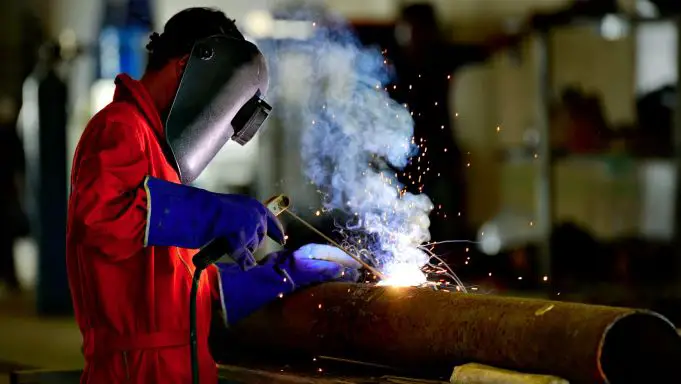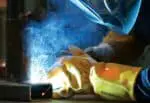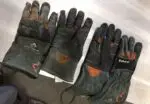When it comes to welding safety, high-quality welding gloves are required to safeguard the hands against all welding hazards. They are designed to keep hands safe from heat, flames, and all other welding hazards.
According to ANSI Standard Z49.1, all cutters and welders must wear protective gloves and the welding process dictates the type of gloves used.
The quality of welders’ hand protection equipment is critical. As a result, they must be aware of the gloves’ durability, safety features, and other details. Many questions arise while selecting appropriate work gloves
Among these factors, the glove material is one of the deciding factors.
To be clear, welding safety gloves are generally composed of leather because of their sturdy nature. In most situations, manufacturers blend multiple types of leather to create a nice pair that combines the finest qualities of each material.
Benefits of leather welding gloves
1.) Safety layer for your hands.
Electrical safety- leather is a good electricity insulator that protects you from electric shock.
Thermal safety- protects your hands from sparks, slag, spatter, molten metal, fire, arc rays, flames, and heat.
Mechanical safety- protects your hands against dangers that include punctures, rips, scratches, and wounds.
2.) Preventing burns- When welding, welders get to handle the arc and sparks, molten metal splatter, and hot metal fly everywhere during this procedure. They would cause serious burns if they came into touch with the skin surrounding the hands.
Therefore, leather gloves are built with the appropriate thickness to avoid burning. They will not shrink when exposed to heat and will not burn through or wear out soon.
3.) Protection against scratches and cuts- When working with metal, there is a considerable risk of being cut or scratched. While the incisions may not appear to be deep, the region may get infected, causing more harm to the hands. This is why wearing hand protection is critical.
The one thing you should know is that the appropriate welding gloves may make a significant difference in how you operate. It has an impact on your welding pace, skill, and safety. Leather gloves are quite useful for preventing scratches and cuts.
Why is leather a popular choice for welding glove material?
Because of their non-conductive, robust, durable and heat-dissipating properties, various leather materials are used to produce welding gloves.
These are the features that a welder needs in their gloves in order to protect their hands and skin from welding risks.
Various categories of leather used in the making of welding gloves
1.) Goatskin: Welding gloves made of goatskin give wearers greater flexibility and dexterity. It is a flexible yet long-lasting material for use in severe situations.
2.) Cowhide: It is a strong, durable material that has a high level of abrasion resistance. They are strong enough to withstand repeated contact with rough and sharp edges. It is also resistant to heat and flame, making it perfect for welding jobs.
3.) Deerskin: Deerskin is used by manufacturers to build soft and comfy welding gloves. This fabric also provides employees’ hands with good sensitivity and dexterity while handling tiny things.
4.) Elk leather: All of the leading manufacturers in welding gloves make at least one model out of elk leather. It is a high-quality leather that remains supple and comfy while effectively insulating against heat.
5.) Pigskin: The tiny pores that enable exceptional ventilation is the material’s distinguishing feature. Furthermore, pigskin is extremely durable, producing robust gloves with their porous textures. However, this material may not be the finest at withstanding high temperatures.
Several factors must be examined while comparing the quality of the gloves under consideration, because at the end of the day, all you need to consider is your safety.
Characteristic of a Good Glove
Gloves are required for all types of industrial operations. They are especially crucial for welders who face increased risk owing to the inherent dangers of the profession.
The proper type of gloves protect against hazards such as hot metal, sparks, grease, chemicals, hot flying particles, cuts, abrasion, and collision.
Welders are constantly exposed to these dangers. As a result, it is recommended that they wear adequate gloves at all times when welding.
You will be able to select the ideal alternative for your unique needs if you are aware of the required qualities of the best welding gloves. Let’s have a look at some of them:
-
-
- Insulation against heat and electricity
- Resistance to moisture
- Size and fit should be proper
- Flexibility and pliability are required to ensure complete range of motion
- Materials of high quality and durability
- Resistance to abrasion and tears
- Durability
-
It is critical that welding gloves provide a high level of safety. However, it is also critical that they allow complete flexibility of movement for precise welding and manipulation of tiny work parts.
Some welding gloves are so thick that it prevents proper flexibility of movement. Remember that top quality welding gloves improve speed and accuracy while also providing welders with a solid grip.
Leather gloves are useful in this situation. It is also critical that the gloves retain an appropriate balance of dexterity and safety.
There are different welding gloves for each different welding technique. Let us have a look at it.
Welding gloves for MIG welding
If you’re doing MIG welding, you’ll need high-quality goatskin gloves with a heat-resistant lining. This is due to the high levels of heat and splatter generated during the MIG process.
This is why gloves with many layers are manufactured thicker.
Check out these recommended gloves for MIG welding-
1.) FOOWOO Cowhide Leather MIG Welding Gloves
- EXTREME HEAT RESISTANT PROTECTION
- INDUSTRIAL DURABILITY
- DURABLE KEVLAR STITCHING
- WIDE RANGE APPLICAT
Prices pulled from the Amazon Product Advertising API on:
Product prices and availability are accurate as of the date/time indicated and are subject to change. Any price and availability information displayed on [relevant Amazon Site(s), as applicable] at the time of purchase will apply to the purchase of this product.
Provides good protection against heat and is durable. Comes with fine Kevlar stitching which means you are well protected against sparks and abrasions.
2.) TOOLIOM Leather MIG Welding Gloves
- THICK AND DURABLE MEATERIAL
- FULL PROTECTION
- KEVLAR REINFORCED FINGER, PALM
- SUPERIOR DES
Prices pulled from the Amazon Product Advertising API on:
Product prices and availability are accurate as of the date/time indicated and are subject to change. Any price and availability information displayed on [relevant Amazon Site(s), as applicable] at the time of purchase will apply to the purchase of this product.
Natural cowhide split leather of high quality allows these gloves to have better control and work at high temperatures. It is also heat resistant, making it ideal for welding work.
Welding gloves for TIG welding
The finest TIG welding gloves offer a high level of dexterity. Heat and spatter protection are not as important as they should be in other forms of welding. It is more vital for you to be able to do your task precisely.
TIG welding gloves made of goatskin are an excellent choice. They give endurance while also allowing you to move quickly.
Check out some recommended gloves for TIG welding-
1.) Superior Goatskin Leather TIG Welding Glove
- KEVLAR STRONG
- GOATSKIN LEATHER
- ASTM ANSI Cut Level A2, ASTM ANSI Puncture Resistance Level 3 and ASTM ANSI Heat Level
Prices pulled from the Amazon Product Advertising API on:
Product prices and availability are accurate as of the date/time indicated and are subject to change. Any price and availability information displayed on [relevant Amazon Site(s), as applicable] at the time of purchase will apply to the purchase of this product.
These superior quality gloves are ideal for protection against dangers that you may encounter in TIG welding. It is extremely durable and strong which means it is not going to wear down after a few uses.
2.) Lincoln Electric Leather TIG Welding Gloves
- HIGH DEXTERITY
- HIGH STRENGTH SEAMS
- LEATHER REINFORCEMENT
- DURABLE LEATHER C
Prices pulled from the Amazon Product Advertising API on:
Product prices and availability are accurate as of the date/time indicated and are subject to change. Any price and availability information displayed on [relevant Amazon Site(s), as applicable] at the time of purchase will apply to the purchase of this product.
These gloves are apt for TIG welding as it provides exceptional dexterity and feel, all of which are required for TIG welding. It has high abrasion resistance and protects the hands and wrist from heat, sparks, and flames.
Welding gloves for Stick welding
A thicker cut of leather is required for stick welding. Elkskin, goatskin, and pigskin split grains are the finest options for stick welding gloves.
Because stick welding methods are straightforward, the user will not require a flexible glove.
Here are some recommended stick welding gloves-
1.) Lincoln Electric Traditional Stick Welding Gloves
- GREAT HEAT RESISTANCE
- INDUSTRIAL DURABILITY
- SUPERIOR COMFORT
- USED BY PROFESSIONALS
- Recommended for Stick welding (SMAW), Mig welding (GMAW), Flux-Core welding (FCAW) or other high temperature applicati
Prices pulled from the Amazon Product Advertising API on:
Product prices and availability are accurate as of the date/time indicated and are subject to change. Any price and availability information displayed on [relevant Amazon Site(s), as applicable] at the time of purchase will apply to the purchase of this product.
To survive everyday exposure to heat, flames, splatter, or sparks while welding, the glove design includes a high grade leather exterior, kevlar threading, leather reinforced stress areas, and a completely lined interior.
2.) Black Stallion Elkskin Stick Welding Gloves
- Premium grain elkskin leather provides superior comfort with natural insulation
- Dupont: Nomex lined back offers extra fire-resistant protection
- Reversed grain palm provides a softer feel against the hand with improved grip
- Thumb strap provides extra reinforcement in a key stress area
- Kevlar stitching provides spark and abrasion resista
Prices pulled from the Amazon Product Advertising API on:
Product prices and availability are accurate as of the date/time indicated and are subject to change. Any price and availability information displayed on [relevant Amazon Site(s), as applicable] at the time of purchase will apply to the purchase of this product.
These gloves provide superior comfort and natural insulation because of the premium quality elkskin leather. And the Nomex-lined back provides further fire-resistance while Kevlar stitching improves abrasion and spark resistance.
Conclusion
Overall, the best welding gloves for you will be different from the best welding gloves for someone else. However, leather is the most sorted material that is suitable for welding gloves.
But do consider the intricacies of TIG, MIG, and stick welding and be aware of what you need to protect yourself against.
Each pair of gloves provides significant protection, but don’t forget to consider how well they’ll do their function.













